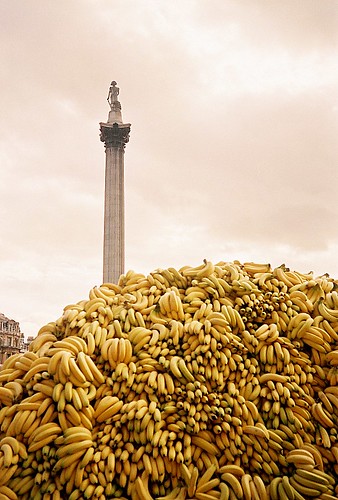Banana 3.0
Posted by Big Gav in bananas
AlterNet has the latest iteration of the story about the demise of the second generation Cavendish banana - Bananas: A Parable for Our Times.
Below the headlines about rocketing food prices and rocking governments, there lays a largely unnoticed fact: bananas are dying. The foodstuff, more heavily consumed even than rice or potatoes, has its own form of cancer. It is a fungus called Panama Disease, and it turns bananas brick-red and inedible.
There is no cure. They all die as it spreads, and it spreads quickly. Soon -- in five, 10 or 30 years -- the yellow creamy fruit as we know it will not exist. The story of how the banana rose and fell can be seen a strange parable about the corporations that increasingly dominate the world -- and where they are leading us.
Bananas seem at first like a lush product of nature, but this is a sweet illusion. In their current form, bananas were quite consciously created. Until 150 ago, a vast array of bananas grew in the world's jungles and they were invariably consumed nearby. Some were sweet; some were sour. They were green or purple or yellow.
A corporation called United Fruit took one particular type -- the Gros Michael -- out of the jungle and decided to mass produce it on vast plantations, shipping it on refrigerated boats across the globe. The banana was standardised into one friendly model: yellow and creamy and handy for your lunchbox.
There was an entrepreneurial spark of genius there -- but United Fruit developed a cruel business model to deliver it. As the writer Dan Koeppel explains in his brilliant history Banana: The Fate of the Fruit That Changed the World, it worked like this. Find a poor, weak country. Make sure the government will serve your interests. If it won't, topple it and replace it with one that will.
Burn down its rainforests and build banana plantations. Make the locals dependent on you. Crush any flicker of trade unionism. Then, alas, you may have to watch as the banana fields die from the strange disease that stalks bananas across the globe. If this happens, dump tons of chemicals on them to see if it makes a difference. If that doesn't work, move on to the next country. Begin again.
This sounds like hyperbole until you study what actually happened. In 1911, the banana magnate Samuel Zemurray decided to seize the country of Honduras as a private plantation. He gathered together some international gangsters like Guy "Machine Gun" Maloney, drummed up a private army, and invaded, installing an amigo as president.
The term "banana republic" was invented to describe the servile dictatorships that were created to please the banana companies. In the early 1950s, the Guatemalan people elected a science teacher named Jacobo Arbenz, because he promised to redistribute some of the banana companies' land among the millions of landless peasants.
President Eisenhower and the CIA (headed by a former United Fruit employee) issued instructions that these "communists" should be killed, and noted that good methods were "a hammer, axe, wrench, screw driver, fire poker or kitchen knife". The tyranny they replaced it with went on to kill more than 200,000 people.
But how does this relate to the disease now scything through the world's bananas? The evidence suggests even when they peddle something as innocuous as bananas, corporations are structured to do one thing only: maximise their shareholders' profits. As part of a highly regulated mixed economy, that's a good thing, because it helps to generate wealth or churn out ideas. But if the corporations aren't subject to tight regulations, they will do anything to maximise short-term profit. This will lead them to seemingly unhinged behavior -- like destroying the environment on which they depend.
Not long after Panama Disease first began to kill bananas in the early 20th century, United Fruit's scientists warned the corporation was making two errors. They were building a gigantic monoculture. If every banana is from one homogenous species, a disease entering the chain anywhere on earth will soon spread. The solution? Diversify into a broad range of banana types.
The company's quarantine standards were also dire. Even the people who were supposed to prevent infection were trudging into healthy fields with disease-carrying soil on their boots. But both of these solutions cost money -- and United Front didn't want to pay. They decided to maximize their profit today, reckoning they would get out of the banana business if it all went wrong.
So by the 1960s, the Gros Michel that United Fruit had packaged as The One True Banana was dead. They scrambled to find a replacement that was immune to the fungus, and eventually stumbled upon the Cavendish. It was smaller and less creamy and bruised easily, but it would have to do.
But like in a horror movie sequel, the killer came back. In the 1980s, the Cavendish too became sick. Now it too is dying, its immunity a myth. In many parts of Africa, the crop is down 60 percent. There is a consensus among scientists that the fungus will eventually infect all Cavendish bananas everywhere. There are bananas we could adopt as Banana 3.0 -- but they are so different to the bananas that we know now that they feel like a totally different and far less appetizing fruit. The most likely contender is the Goldfinger, which is crunchier and tangier: it is know as "the acid banana."
Thanks to bad corporate behavior and physical limits, we seem to be at a dead end. The only possible glimmer of hope is a genetically modified banana that can resist Panama Disease. But that is a distant prospect, and it is resisted by many people: would you like a banana split made from a banana split with fish genes?






